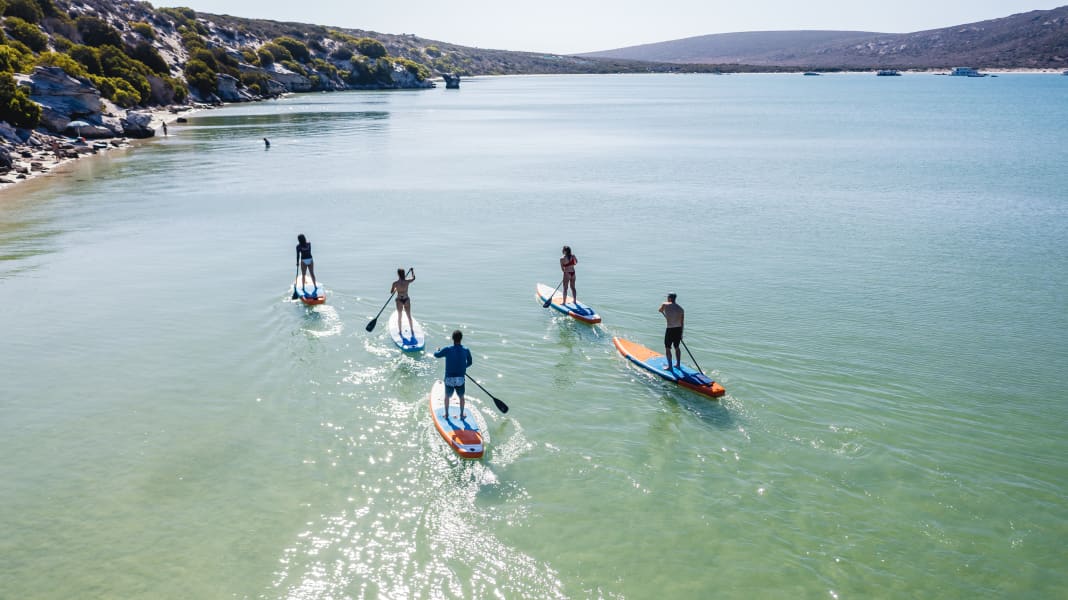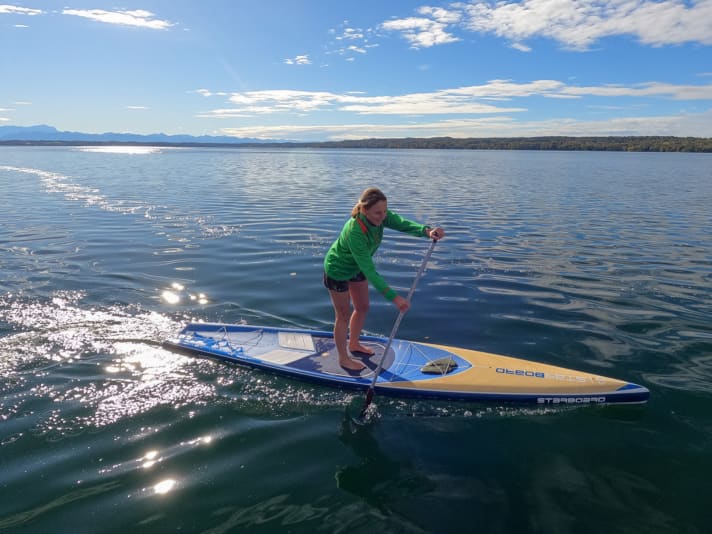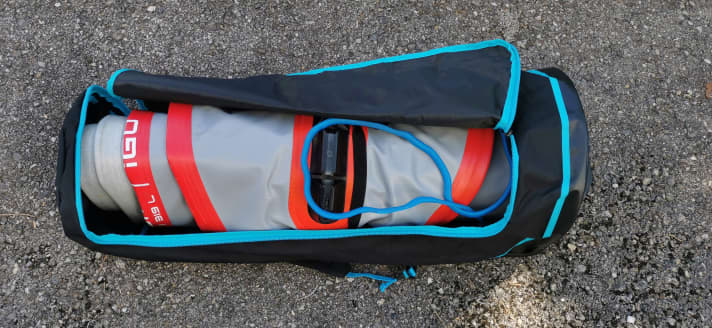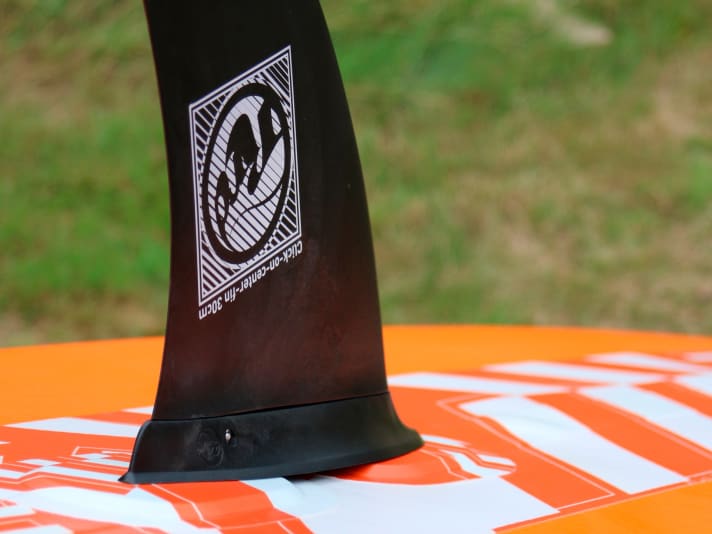
In this article:
"What types of SUP boards are there?" To give you an overview, we have listed the most important board groups here - although in most cases only two or three of these are even worth considering. It gets very specific from the race boards onwards at the latest. Here are the different board classes in the order in which the boards are most likely to be purchased.
- All-round boards
- Touring boards
- WindSUPs
- Yogaboards
- Raceboards
- Waveboards
- Whitewater boards
The following board guide is therefore not aimed at those looking for a high-end race board or a wave board for the Danish North Sea, but at families or SUP fans who
- want to enjoy nature on tours - on the lake or river,
- want to take advantage of the incredible fitness opportunities,
- simply looking for relaxed paddling and swimming fun with the family.

Four simple questions will help you find the right board:
- Should it be a hardboard or an inflatable board?
- What length makes sense?
- How wide does it need to be?
- Should it have an additional benefit (windsurfing, wingsurfing, yoga, etc.)?
1. hardboard or iSUP?
Even though inflatables (inflatable SUPs, also known as "iSUPs") are now almost exclusively sold over the counter, a laminated hardboard is also an option for some people.

This is what (inflatable) iSUPs offer:
Inflatable boards Inflatables, often referred to as iSUPs, now work almost as well as the (usually heavier) laminated boards. The design trick is thousands of threads that are woven and glued between the top and bottom, allowing the boards to be inflated at high pressure without turning into a round sausage.

Advantages and disadvantages of an inflatable board:
- Light (often less than 10 kilos)
- Small pack size for storage and transport
- More favourable price than hardboards
- Quite robust in contact with (round) stones (shallow river beds), on pebble beaches or rocky areas
- Very suitable as a sunbathing area and playground for children
- Well suited for river tours - also for carrying passages
- Inflating by hand takes between five and ten minutes.
Advantages and disadvantages of a laminated hardboard:
- More stable than an iSUP with the same width because it is generally thinner
- Enable around 10 per cent higher touring speed
- Less paddle pressure required at the same speed
- Smoother, more direct driving experience
- Very long service life possible because easy to repair
- Mostly heavy (touring boards weigh 13 to 17 kilos depending on construction)
- Very unwieldy on land depending on length
- Sensitive to impacts during handling on land or stone contact
- No inflation necessary
- High price
- Easily accessible storage space required
- Transport by car only with a roof rack or in a very long van
2. how long should a SUP be?
The length determines the speed and manoeuvrability. The longer a board is, the faster it can be paddled on average when touring and also gains a few tenths of a kilometre per hour at top speed with every foot. The shorter a board is, the easier it turns. Long boards, on the other hand, paddle better straight ahead, which means you don't have to change sides as often. The recommended length therefore depends on the area of use. As with surfboards for surfing, the length is usually given in feet and inches. An 11'6'' board is therefore 11 feet and 6 inches long. This takes some getting used to, which is why we have already converted the following (1 inch = 2.54 cm; 1 foot = 30.5 cm)
- All-round boards: 10'4'' to 11'8'' (3.15 to 3.55 metres)
- Touring boards: 11'6'' to 14' (3.50 to 4.21 metres)
- Whitewater boards: 9 to 11 feet (2.74 to 3.35 metres)
- Raceboards: Almost exclusively 14 feet (4.27 metres)
- Yogaboards: 10'4'' to 11'2''
The boards for SUP beginners will usually settle between 10'4'' and 12'6''. Longer boards are slightly faster and run better in a straight line (more paddle strokes are possible on one side) and, with more volume, are also better at carrying luggage for tours.
Rule of thumb: If you intend to paddle mainly within sight of the beach, lengths between 10'4'' and 11'6'' are ideal. Heavier people go for the slightly longer boards, lighter people for the shorter ones.
- A 10'4'' Board is very manoeuvrable,
- An 11'6''it is already well suited for touring.
- 12'6''er are the classic touring boards that paddle very well in a straight line but are also easy to turn and offer plenty of space for luggage. These boards are particularly suitable for regular tours of an hour or longer. Also suitable for calm to moderately flowing waters
- Boards with 14 feet are clearly designed for the long haul without a lot of manoeuvring.

3. how wide should a SUP be?
The right width for getting started is between 30 and 34 inches, depending on your body weight. If the board is narrower than 32 inches, it can quickly become a little tippy for larger paddlers. A small classification for an overview:
- 25 inch Width: Pure race board, comparable to racing canoes, extremely tippy and can only be paddled safely (dry) in slightly choppy water with a lot of practice.
- 29 inch Width: A sporty touring size. For sporty paddlers who see the slightly tippy board as a challenge. Or for light touring paddlers under 75 kilos.
- 31 inch Width: Typical dimension for touring boards for paddlers between 70 and 85 kilos with an average sense of balance.
- 32 inch Width: All-round boards for relaxed touring paddling and as a family board or for tours with more luggage. Also a very common size for all-round boards (e.g. 10'4'' x 32'').
- 33 inch Width: Often chosen for stable all-rounders (10'8'' x 33'') on which a parent and child can paddle and for yoga boards.
- 34 inch Width: Very stable and stable. For paddlers over 90 kilos.
The recommendations apply to inflatable boards. Due to their sharper edges, fixed boards are usually slightly more stable than inflatable boards and can therefore be selected around 1-2 inches narrower.
4. how thick should a SUP be?
The thickness is particularly important for inflatable boards. Hard (laminated) boards always have sufficient stiffness due to their hard construction, no matter how thin the board is. With inflatable boards, the thickness has a noticeable effect on the stiffness. You can often find very favourable offers in four inch thickness - and children's boards. We would be reluctant to recommend boards with a four-inch thickness, and if so, only to very light paddlers (< 60 kilos), as these boards often flex noticeably more, and cold water (in spring) tends to slosh over the deck. The advantage is the slightly lower weight. On the other hand, you really get the feeling of standing on an inflatable board. On a six-inch thick board, you could sometimes forget that. Heavy paddlers (>80 kilos) should definitely choose a correspondingly thick 6-inch board, whereas four inches is "thick" enough for children's boards - the kids stand lower, making them more stable and simply closer to the water. Some - including premium brands - offer boards that are 5.5 inches thick, which are also easy to paddle. However, paddlers in the over 95-kilo class are always on the safe side with a 6-inch board.
The 5 best SUP type recommendations
We have preconfigured boards for the five most common areas of use. If you are very unsure, choose an inch wider, very light riders and people with good balance can also choose an inch narrower.
All-round board for the family
Easy to turn and stable, a board measuring around 10'4'' to 10'8'' long x 33'' wide can be used for a wide range of purposes: as a play and bathing island, for exploring the surrounding lakeshore, for sunbathing and even for a short lake crossing or a proper river trip.
For sporty trainers
12'6'' long and about 29'' to 31'' wide with a slim bow and tail. For fast laps on the lake or day trips with medium luggage. Very light people can also make light and swift progress with a board in 11'6'' x 27'' to 29''.
For (longer) SUP tours
The board is 32 inches wide and 12'6'' long for sufficient load capacity and tipping stability. If you are planning very long tours, you can also opt for 14 feet. For river tours with carrying passages, a 12'6'' remains noticeably more manageable.
SUP for fun, relaxation and yoga
Under 11 feet long and at least 32 inches wide, the board offers plenty of space on deck. It is important that the deck surface is large enough and that there are as few annoying handles or nets in the way as possible that cannot be removed.
SUP for wingsurfing or windsurfing
You can find more information and a full video below. Ideally, the dimensions should be between 10 and 11 feet long and at least 32 inches wide. It is important that a fin can be mounted in the centre as well as a base plate, then there is little in the way of fun with a wing or sail.
Windsurfing or wingsurfing included: SUP becomes WindSUP
SUPing is fun on smooth water and without wind. So what could be more obvious than simply putting a sail on it when the wind comes up and going windsurfing? For this to be possible, SUPs must fulfil the following criteria:

Base plate holder:
In order to be able to mount a base plate - the connecting piece between the board and sail - a thread or a mast rail must be installed in the deck. This is by no means the case with all SUPs!

Centre fin or daggerboard:
In order to be able to cross upwind in light winds, it is important to have a centre fin or daggerboard. SUPs with a windsurfing option therefore often offer the option of inserting a centre fin on the underside.

With this information, you should now be well equipped to find a suitable board for you.

